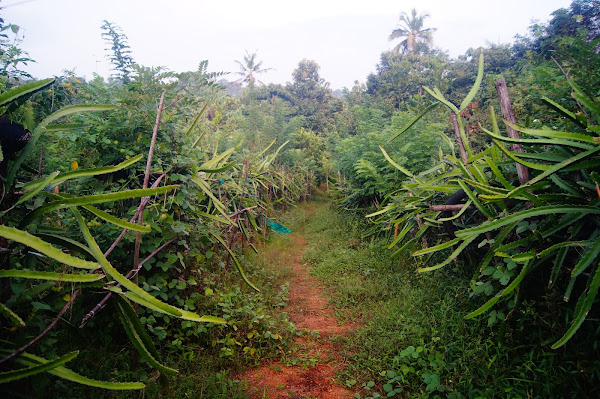Ivy gourd and bitter gourd integrated farming at Liz Pepper Gardens
Ivy gourd and bitter gourd integrated farming at Liz Pepper Gardens" is our thoughtful approach to combining the cultivation of ivy gourd (Coccinia grandis) and bitter gourd (Momordica charantia). This integrated farming method is designed to optimize space, resources, and yields while providing mutual benefits for both crops. Here's an overview of how these climbers are grown and supported in Liz Pepper Gardens:
Support System:
In integrated farming, the support system for ivy gourd and bitter gourd is crucial for their healthy growth and efficient space utilization. Typically, a vertical support structure is employed, such as trellises or stakes, to guide the climbers upward. This not only minimizes ground space usage but also facilitates better exposure to sunlight and air circulation, promoting overall plant health.
Planting and Spacing:
The process begins with careful planning of the garden layout. Ivy gourd and bitter gourd are planted in proximity but with adequate spacing to prevent overcrowding. Both plants are climbers, and they naturally tend to spread out. Ensuring proper spacing helps avoid competition for sunlight, nutrients, and water.
Soil Preparation:
Well-draining, nutrient-rich soil is essential for the successful cultivation of ivy gourd and bitter gourd. Liz Pepper Gardens likely prepares the soil by incorporating organic matter and maintaining the right pH levels. This creates a conducive environment for root development and nutrient absorption.
Climbing Mechanism:
For both ivy gourd and bitter gourd, tendrils are employed for climbing. Tendrils are slender, thread-like structures that extend from the plant, allowing them to latch onto the support structure. Liz Pepper Gardens may utilize soft ties or twine to gently secure the vines to the trellises or stakes, ensuring upward growth and stability.
Cultivation Practices:
Integrated farming involves synchronized cultivation practices. Both ivy gourd and bitter gourd require regular watering, particularly during dry periods, to maintain consistent soil moisture. Mulching is often applied to conserve moisture and suppress weeds. Additionally, periodic fertilization with a balanced fertilizer helps meet the nutritional needs of the plants.
Harvesting:
The integrated farming approach allows for a staggered and continuous harvest. Ivy gourd and bitter gourd are typically ready for harvest when they reach a mature size. Regular harvesting encourages the plants to produce more, promoting a sustained yield throughout the growing season.
Benefits of Integrated Farming:
Optimized Space: Growing ivy gourd and bitter gourd vertically maximizes the use of available space.
Complementary Growth: The two crops can complement each other in terms of nutrient requirements, reducing the risk of depletion.
Pest Management: Integrated farming may provide a natural form of pest management, as certain pests that affect one crop may be deterred by the presence of the other.
*The provided video is from the account of one of the members of the Liz Pepper Gardens team, previously called The Attic Art YardHere, the integration of pavakka (bitter gourd) and kovakka (ivy gourd) takes center stage, creating a lush canopy where climbers intertwine to form a verdant ceiling. The unique feature of this lies in the creation of a designated shade area, a living roof under which visitors can walk, immersing themselves in the thriving ecosystem.
Supportive Canopy and Vertical Pillars:
At Liz Pepper Gardens, the pavakka and kovakka vines are not merely left to climb; they are guided to create a functional and aesthetic structure. Triangular pillars, strategically placed, serve as robust supports for the climbing plants. The vines gracefully ascend these pillars, weaving a natural curtain that not only supports their growth but also provides shade underneath. This design showcases an innovative fusion of agriculture and architecture, transforming the farm into an inviting space where the beauty of nature meets practical utility.
Walking Under the Green Canopy:
Visitors to Liz Pepper Gardens are treated to a unique experience as they stroll beneath the green canopy formed by the entwined pavakka and kovakka vines. The shade area offers a refreshing retreat from the sun, providing a cool and tranquil ambiance. The interplay of sunlight filtering through the leaves creates a dappled effect on the ground, turning a simple walk into a sensory delight. This immersive experience invites individuals to connect with the agricultural process in a harmonious environment.
Triangular Pillars and All-Encompassing Farming:
Beyond the pavakka and kovakka integration, Liz Pepper Gardens takes pride in a holistic approach to farming. The triangular pillars serve as versatile structures, accommodating various crops and enhancing the overall productivity of the farm. This innovative farming model reflects a commitment to sustainable and efficient land use, where different crops coexist harmoniously, each contributing to the overall health and diversity of the ecosystem.
Malayalam Names - Pavakka and Kovakka:
In the rich linguistic tapestry of Malayalam, bitter gourd is affectionately known as "pavakka," while ivy gourd goes by the name "kovakka." These names resonate with the cultural heritage of the region, adding a touch of local identity to the thriving agricultural landscape at Liz Pepper Gardens.
In essence, the shade-covered pavakka and kovakka vines not only yield bountiful harvests but also create a captivating environment that invites all to appreciate the beauty of sustainable and integrated farming.





Comments
Post a Comment